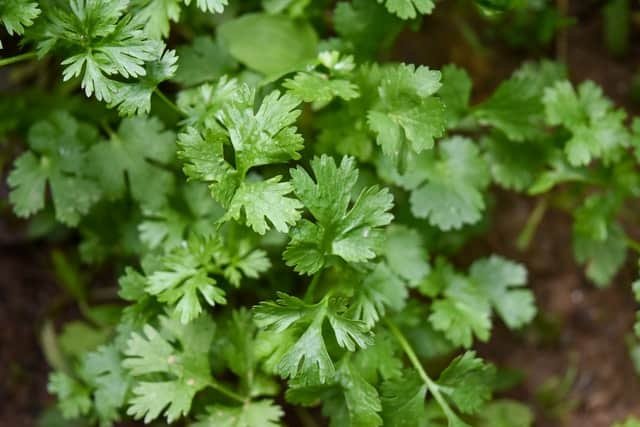
What flavors come to mind when you think of Mediterranean cuisine? Any ideas? Let us help you with a saying: you are like… parsley.
Popular culture coined sayings like the one above to tell someone that you find them everywhere; just like parsley, a plant native to the central Mediterranean area and undoubtedly one of the omnipresent condiments in your kitchen.
However, the consumption of parsley does not only respond to its gastronomic qualities. Its richness in iron and vitamins, as well as its properties to treat disorders of the digestive system mean that parsley infusion or parsley juice is often consumed for medicinal reasons.
Plant
Parsley is a plant of Mediterranean origin, but introduced and naturalized to many other areas of the world. It grows well in temperate zones, around walls and rocky terrain. Not in vain its name, petroselinum crispum, comes from the Greek word petrol, which means stone or rock, and refers to the preference of this plant for rocky soils.
Parsley is native to Greece and the island of Sardinia, although today it is grown in many parts of the world. In the wild it is also found in North Africa and South-west Asia.
There are three varieties of parsley, the curly leaf variety; continental or flat-leaved; and finally, the Hamburg parsley, from which the root is consumed, which is similar to that of the parsnip.
Parsley belongs to the apiaceae family, like fennel, celery or carrots. Its cultivation has been documented for 300 years and it is one of the most used aromatic plants in the kitchen worldwide.
Origin of parsley and history
The Mediterranean origin of parsley made the Greeks and Romans use it as a condiment in their stews.
Beyond cooking, the Greeks used parsley to crown their victorious athletes and as a funeral garnish.
In their conquests, the Romans brought parsley from the Mediterranean to England. Dioscorides, doctor of Nero’s armies, recommended that soldiers always carry parsley with them to recover energy quickly and they usually consumed it before battles.
Parsley was also part of the selection of plants that Charlemagne, the founder of the French and German monarchies, ordered to be grown in all his imperial gardens.
Does your greengrocer give you parsley when you go shopping? This custom began in the 13th century, when Christian merchants started it to mock the Jews, who highly valued this plant.
In the Middle Ages, parsley became so popular in the kitchen that popular phrases such as “you are like parsley” were created, with which we used to open the article, to tell someone that you find it everywhere.
How to make parsley tea
There are several ways of medicinal consumption of parsley. Parsley can be found in powder to be consumed in pills, in the form of essential oil or it can be prepared in the form of juice, decoction of its root or infusion.
To prepare a good infusion, pay attention to these 5 points.
1. Infusion of fresh parsley better than dry
Parsley easily loses its properties. Therefore, it is highly recommended to use fresh parsley instead of dried. If you like parsley infusion, why don’t you dare to plant some? Growing it at home is simple, parsley is a grateful plant and can grow well as an indoor plant as long as it has a little light. Of course, it needs a lot of water, if you forget about it, it will not last long. When you want to use it, simply pluck off the leaves without damaging the main stem, parsley grows quickly and will form new stems and petioles right away.
If gardening is not for you, you always have the option of freezing it, this largely preserves its nutritional properties.
2. Watch out for the heat
In addition to easily losing its aroma, parsley also easily loses its properties. It is important to know that, by adding it as a condiment during any cooking, part of its vitamin components are lost. Therefore, when you make it as an infusion, be careful not to “burn” it with water that is too hot.
Bring water to a boil and pour it into the cup when it reaches 80º C. If you don’t have a thermometer, bring the water to a boil and let it sit for a few minutes before pouring it.
3. Do not soak it
Another recommendation for its preparation is not to soak the parsley, vitamin C is water-soluble and is lost in these circumstances. You can (and should) wash it, but don’t let it soak too long.
4. Quantities
To make an infusion from dried parsley, put about 2 teaspoons per cup. If you use fresh parsley, remember that you can put the plant without cutting, it is not necessary to chop the leaves. Use about 5 sprigs of parsley.
5. Times
Let the infusion rest for at least 3 minutes. The infusion will gain color and aroma.
Nutrients
Parsley stands out for its vitamin A content, essential for the development of soft tissues, bones and teeth. Vitamin A is also related to the prevention of infectious diseases and the proper functioning of the female reproductive cycle and the production of sperm.
Parsley is a source of calcium, iron, potassium, flavonoids, antioxidants, and fiber, as well as other non-nutritive substances such as apiol and myristicin. It is also an excellent source of vitamin C.
Properties of parsley in infusion
Parsley infusion is a comfortable and effective way to take advantage of its health benefits. The taste is peculiar, but nothing unpleasant. Let’s see below how it can help you feel better.
Beneficial for the digestive system
Parsley has beneficial properties for the kidney and digestive system. It has diuretic properties that help eliminate fluids and make it useful for treating edema and related conditions. It also promotes digestion.
The parsley as a good remedy for treating urinary tract infections and preventing and treating the formation of kidney stones.
Parsley also helps eliminate gas and cramps due to its carminative properties.
Emmenagogue
Parsley consumption promotes menstrual flow and relieves pain related to menstruation. This is due to the presence of apiol and myristicin, which are part of its essential oils.
Antianemic
Parsley has traditionally been used to combat anemia. Parsley has a high composition of iron and vitamin C, this makes iron absorption much more effective.
On the other hand, parsley promotes hunger.
Rich in antioxidants
Parsley is rich in ascorbic acid, popularly known as vitamin C. It also contains other antioxidants such as flavonoids and carotenoids.
These compounds, present in food, help our body fight against oxidative stress, a phenomenon that science has linked to various diseases.
Diuretic
Parsley infusion is an excellent way to stimulate our kidneys.
Parsley’s diuretic properties are well known in traditional medicine, which often recommends it to stimulate urine production. Scientific studies have tested these assumptions on animals.
Parsley would also modify the pH of the urine, making it more acidic. In this way, it could help prevent kidney stones.
Blood sugar control
There are scientific studies on animals that substantiate the properties of parsley to moderate blood sugar. Interestingly, in Turkey, parsley is considered by folk medicine to have sugar-controlling properties.
At the moment, the research is still inconclusive in this regard.
Contraindications

Parsley consumption should be monitored during pregnancy and lactation. Although its consumption in usual doses as a condiment in food does not entail danger, its consumption in large doses does (parsley complements, infusions…). Parsley has uterotonic, menstrual flow-stimulating, and abortifacient effects.
Parsley might also affect the rate of blood clotting, so it’s not recommended for people with bleeding disorders.
The effects of parsley to promote sodium retention in the body are also known, this would negatively affect situations such as hypertension and fluid retention.
